
The SHAPE Update, Volume 1, Issue 1 - Healthy Eating & Nutrition Education (CA Dept of Education):
The SHAPE Update, Volume 1, Issue 1
Fall 2011 Shaping Health as Partners in Education (SHAPE) e-newsletter to provide SHAPE agencies with information, opportunities, and ideas to assist their ongoing development of healthier school environments.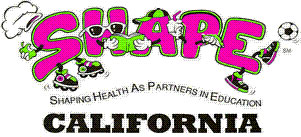
SHAPEing Success | What's the Buzz? | Trainings | Funding Opportunities | Initiatives
Resources | Research | Policy Updates
Resources | Research | Policy Updates
About Our New E-Newsletter
The California Department of Education’s (CDE) Nutrition Services Division (NSD) introduces our brand new Shaping Health As Partners in Education (SHAPE) E-Newsletter. The purpose of this E-Newsletter is to provide our SHAPE agencies with information, opportunities, and ideas to assist their ongoing development of healthier school environments. The content includes current information about upcoming trainings, funding opportunities, initiatives, useful resources, research, and policies, as well as an opportunity for SHAPE agencies to share best practices performed within their school districts, providing other SHAPE agencies with new ideas for creating healthier school environments.
The parent newsletter template(DOC; 148KB; 1p.) and attachment(PDF; Outside Source) are available for SHAPE schools to send home to their student’s parents. Please modify the newsletter as necessary for your audience.
About the Editor
My name is Emily Dimond. I am a Student Assistant and the SHAPE E-Newsletter Editor in the NSD’s Education and Nutrition Policy Unit. I am a junior majoring in Applied Nutrition, a certified Didactic Program in Dietetics approved by the American Dietetic Association, with a minor in Studio Art at California Polytechnic State University, San Luis Obispo. Upon graduation, I plan to pursue graduate work in community nutrition and become a Registered Dietitian. I have a passion for health, food, and education, which drives my creation of the SHAPE E-Newsletter. I hope this newsletter provides you with information to help you build a healthier school environment. Please contact me by e-mail at edimond@cde.ca.gov if you have any questions regarding the information provided in this newsletter.
SHAPEing Success
El Monte City School District Shapes Success in its School Lunch and Breakfast Programs!
By Robert S. Lewis, Director of Nutrition Services, El Monte City School District
In its efforts to serve healthier student meals, the El Monte City School District (EMCSD) has made several positive changes this past school year.New menu items were put into place in order to meet the guidelines set by the American Heart Association and the U.S. Department of Agriculture (USDA).Through these changes, EMCSD is prepared to introduce the new meal standards set by the Institute of Medicine and the National School Lunch and Breakfast Programs. Entrées have been revised to reflect healthier options. For example, chicken nuggets have been replaced by teriyaki chicken with brown rice, corn dogs and hot dogs have been replaced with barbecue turkey sandwiches, and we now offer whole-grain sub sandwiches prepared with lean deli meats and cheeses.
Share your story about how you are creating a healthier school environment in your SHAPE school or school district here!
The NSD encourages SHAPE agencies to use this newsletter as a communication tool to share best practices within SHAPE agencies in California. If you have any questions or would like to share a “SHAPEing Success” story, please contact Emily Dimond, SHAPE E-Newsletter Editor, by phone at 916-445-9162 or by e-mail at edimond@cde.ca.gov.
What’s the Buzz?
The CDE’s Team California for Healthy Kids Campaign
State Superintendent of Public Instruction Tom Torlakson launched the Team California for Healthy Kids (TCHK) campaign in October 2011 to promote healthy eating and physical activity throughout the day, every day, in schools, before and after school programs, child care programs and communities. The campaign focuses on making healthy choices the easy choices.
Rigorous research confirms the clear connection between health, learning, and attendance.
- Healthy children:
- Are more successful in school
- Miss fewer days of school
- Are more attentive and well-behaved
- Are more likely to graduate from high school and go to college
- Health disparities contribute to the achievement gap
Superintendent Torlakson has long been a champion for students’ health. He knows that healthy students not only excel academically, but also are more likely to be positively engaged in social, community, and extra-curricular activities. The benefits of supporting student health are far reaching.
The goals for the first two years of the campaign are to:
- Increase physical activity, especially moderate-to-vigorous physical activity throughout every day, in schools and communities
- Increase access to water and fresh foods, particularly salad bars
For more information and campaign updates, please visit the CDE TCHK.
Trainings
SHAPE Training Schedule
The 2011–12 SHAPE workshop series, “Nutrition Education That Works!” will be offered by the NSD from October 2011–March 2012 at nine locations statewide, two of which already occurred in Sacramento and Fresno. These workshops provide skill-based training on how to choose nutrition education curriculum for students, kindergarten through grade twelve, using the 2010 Nutrition Competencies. Online registration is available at the CDE Child Nutrition Information and Payment System (CNIPS).
SHAPE Workshops 2011–12: Nutrition Education That Works!
| Location | Date |
|---|---|
Redding Shasta County Office of Education, Board Room 1644 Magnolia Avenue, Redding, CA 96001 | Tuesday, November 8, 2011 |
Santa Barbara Santa Barbara School District, 1st Floor Conference Room 720 Santa Barbara Street, Santa Barbara, CA 933101 | Tuesday, December 6, 2011 |
Riverside Riverside USD, Training Room 1st floor 6050 Industrial Avenue, Riverside, CA 92504 | Thursday, December 8, 2011 |
Santa Rosa Sonoma County Office of Education, Redwood Room C 5340 Skylane Boulevard, Santa Rosa, CA 95403 | Thursday, January 12, 2012 |
Los Angeles Los Angeles County Office of Education, Room 606 12830 Clark Avenue, Downey, CA, 90242 | Wednesday, January 25, 2012 |
San Jose Santa Clara County Office of Education, Milpitas Room 1290 Ridder Park Drive, San Jose, CA 95131 | Thursday, February 9, 2012 |
Bakersfield Kern County Superintendent of Schools Office, Conference Room 1-B The City Center Building. 1300 17th Street, Bakersfield, CA 93301 | Wednesday, March 29, 2012 |
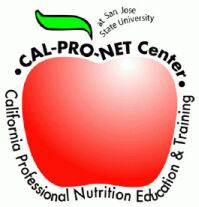 The NSD Sponsored California Professional Nutrition Education and Training Center (Cal-Pro-NET) Trainings Schedule
The NSD Sponsored California Professional Nutrition Education and Training Center (Cal-Pro-NET) Trainings Schedule
Check out the current and upcoming trainings you and your staff members can attend to learn how to create a healthier school environment! Both online and in person trainings are listed in the schedule below.
Current and Upcoming Trainings
| Training Names | Online / In Person | Date | For More Information |
|---|---|---|---|
| Snack Time: Providing Healthy and Affordable Snacks After School | Online | Ongoing | Online training available at CASRC and CHKRC Online Trainings (Outside Source) Contact: Angelina Amarillas at 510-670-4587 or by e-mail ataamarillas@californiaafterschool.org. |
| Competitive Food and Beverage Web-based Training Series | Online | January 2012 | Contact: Mike Danzik at 916-445-7346 or by e-mail at mdanzik@cde.ca.gov |
| Fresh Fruits and Vegetables: The Centerpiece for a Healthy School Environment | In Person | November–December 2011, six fall trainings statewide | For more information, visit Healthy School Environment (Outside Source) Contact: John Fisher, Life Lab Science Program, University of California, Santa Cruz, at 831-459-4035 |
| Wake-up to More Fruits and Vegetables | Online | Ongoing | Online Training available at Wake Up to More Fruits and Vegetables (Outside Source) Contact: Deborah Beall at 916-324-8790 or Jacqueline Bergman at 916-322-3435 |
| Healthy & Active Preschoolers Web site for Child Care Programs | Online | Ongoing | Visit Healthy & Active Preschoolers (Outside Source) Contact: For technical assistance or more information, visit Fresno City College Cal-Pro-NET Center (Outside Source), or call 559-489-2237, or e-mailfcc.calpronet@fresnocitycollege.edu |
Child and Adult Care Food Program Healthy Meals, Healthy Children Training for Child Care Centers, Family Day Care Home Sponsoring Agencies, and Emergency Shelters | In Person | Fall 2011 and Spring 2012 | Visit Fresno City College Cal-Pro-NET Center(Outside Source) Contact: Fresno City College Cal-Pro-NET Center by phone at 559-489-2237, or 559-244-5999 ext. 2376, 2377, 2378, 2379, 2380 or 2381, or by e-mail atfcc.calpronet@fresnocitycollege.edu |
Funding Opportunities
Apply for the 2011 Whole Kids Foundation School Garden Grant!
The Whole Kids Foundation, a charitable organization of Whole Foods Market, and FoodCorps, a national service organization, are dedicated to reversing the trend in childhood obesity by engaging children in physical and academic school garden activities. The two organizations have partnered to offer a unique grant opportunity.
The grant includes:
- A $2000 grant offer to schools, districts, or school-affiliated nonprofit organizations
- Yearlong support and mentoring from FoodCorps
- Access to a resource center providing curriculum, coaching, materials, and ideas
- Participation in gardening discussions and forums with expert assistance
Apply through December 31, 2011—the first grants will be awarded in February 2012. To access details and the application kit visit Whole Kids Foundation School Garden Grants (Outside Source).
You can also visit Whole Kids Foundation (Outside Source) or FoodCorps (Outside Source).
For more information about starting a school garden and to access resources such as school garden curricula and help with grants and fundraising, check out California School Garden Network (Outside Source).
Initiatives
Your Let’s Move! Update
“Let’s Move! is a comprehensive initiative, launched by the First Lady, dedicated to solving the problem of obesity within a generation, so that children born today will grow up healthier and able to pursue their dreams.”1
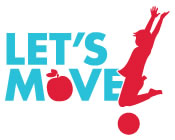 The five pillars of the First Lady’s initiative are:
The five pillars of the First Lady’s initiative are:- Creating a healthy start for children
- Empowering parents and caregivers
- Providing healthy foods in schools
- Improving access to healthy, affordable foods
- Increasing physical activity
As a result of this initiative and its goals, many programs and policies related to the improvement of child health and physical activity have been created and/or enhanced.
The Chefs Move to Schools program, one of the many programs launched by Let’s Move!, is a great start to help create a healthy school environment. Administered by the USDA, this program matches chefs with school districts to help schools improve health and nutrition.
“The chefs adopt a school and work closely with teachers, parents, school nutritionists and administrators. They teach new techniques and recipes for healthier meals that meet the schools’ dietary guidelines and budgets. And, they engage young people in learning about nutrition and making balanced and healthy choices. By creating healthy meals that are also delicious, chefs have a unique ability to make good nutrition fun and appealing.”2
For more information, please visit the Chefs Move to Schools Web page at Let's Move!] (Outside Source).
You can explore the Let’s Move! Web site (Outside Source).
Moving from MyPyramid to MyPlate
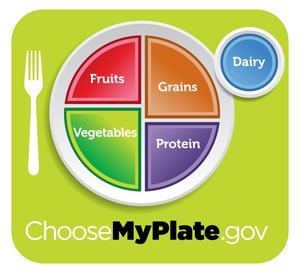 By Jacquelyn Russum, MPH, RD, Health Program Manager, CaliforniaHealthy Kids and After School Resource Centers
By Jacquelyn Russum, MPH, RD, Health Program Manager, CaliforniaHealthy Kids and After School Resource CentersIn June 2011, the USDA released the new MyPlate icon to accompany the 2010 Dietary Guidelines for Americans (DGA). MyPlate replaces MyPyramid as a visual guide for making healthier food choices. Although the appearance has changed, MyPlate still includes the five food groups and the same recommended daily portions that can be personalized according to age, gender, and level of activity.
The USDA is rolling out a variety of educational messages, materials, and tools to support putting MyPlate into practice. A completely updated MyPlate Web site is scheduled for fall/winter 2011 with materials for children and schools. Until then, both MyPlate and MyPyramid resources are available to health professionals and nutrition educators at ChooseMyPlate.gov (Outside Source). Please note that until the full transition to MyPlate occurs, you may continue to use your inventory of MyPyramid materials.
The California Healthy Kids Resource Center (CHKRC) is preparing a packet with an overview of available MyPlate resources and suggestions for adapting nutrition education lessons. The packet will be included in nutrition and physical activity materials available for loan from the CHKRC (Outside Source) under the Hot Topics and More menu.
Take the HealthierUS School Lunch Challenge!
 The HealthierUS School Challenge (HUSSC) was established by the USDA’s Food and Nutrition Services (FNS) to recognize elementary, middle, and high schools that are creating healthier school environments through their promotion of nutritious meals, physical activity, and nutrition education. It supports First Lady Michelle Obama's Let's Move! campaign by acknowledging schools that are working to reduce the childhood obesity epidemic. Four levels of superior performance are awarded and the USDA is offering monetary incentives with each level: Bronze ($500), Silver ($1,000), Gold ($1,500), and Gold Award of Distinction ($2,000).
The HealthierUS School Challenge (HUSSC) was established by the USDA’s Food and Nutrition Services (FNS) to recognize elementary, middle, and high schools that are creating healthier school environments through their promotion of nutritious meals, physical activity, and nutrition education. It supports First Lady Michelle Obama's Let's Move! campaign by acknowledging schools that are working to reduce the childhood obesity epidemic. Four levels of superior performance are awarded and the USDA is offering monetary incentives with each level: Bronze ($500), Silver ($1,000), Gold ($1,500), and Gold Award of Distinction ($2,000).To qualify for an award, a school must submit a formal application and meet or exceed basic criteria set forth by the FNS. The HUSSC criteria reflect the recommendations of the 2005 DGA for foods that should be served in schools and outside of the organized school lunch meals. HUSSC schools must also have a local school wellness policy as mandated by Congress.
The NSD encourages all California schools to apply for an award. Please visit the USDA Team Nutrition(Outside Source) Web page, and select HealthierUS School Challenge to access the HUSSC application and other resources.
Who is taking on the challenge in California?
Since 2010, a total of 60 California schools have received HUSSC certification. Congratulations to the following California school districts for winning an HUSSC award: Bakersfield City School District (SD), Elk Grove Unified SD, Paradise SD, Stanislaus County Office of Education, Shiloh SD, Salida Union SD, and El Monte City SD. View the award-winning schools within each school district at the USDA HUSSC California Award Winners (Outside Source) Web page.
Many more California school districts and schools have been taking on the challenge; in June 2011, the NSD office approved 11 school applications from five more school districts and those awards are currently pending approval at the USDA level.
If you would like to receive a hard copy of the HUSSC Application Kit, or have any questions, please contact Elizabeth Moreno, Nutrition Education Consultant, by phone at 916-324-9749 or by e-mail at emoreno@cde.ca.gov.
The Farm to School Initiative Thrives Across the United States!
The USDA’s Farm to School (F2S) initiative is an effort to connect schools, kindergarten through grade 12, with regional or local farms in order to serve healthy meals using locally produced foods. The USDA recently sent out a report that school involvement has skyrocketed and that the parties involved in the initiative reap many benefits. The report indicates that students benefit from good nutrition from local produce, adding variety to their meals and trying out new foods. Students also gain the opportunity to learn about where their food comes from, thus promoting “buying local.” The F2S connection is also beneficial to local farmers, who report that the steady business they receive from schools helps boost their business. According to Steve Karnowski’s report summary, USDA Seeks Ways to Boost Farm-to-School Programs, the USDA pledged in their report “to step up efforts to connect schools with farmers, including increasing collaboration with nonprofits and expanding outreach and awareness initiatives.”3
Learn more about the initiative at the USDA Farm to School (Outside Source Web page).
We hope that you are participating in the first annual October 2011 National Farm to School Month!
“In November 2010, Congress approved a resolution introduced by Representative Rush Holt (NJ) to officially designate October as National Farm to School Month. The passage of House Resolution 1655 demonstrates the growing importance and role of Farm to School programs as a means to improve child nutrition, support local economies, and educate children about the origins of food.”4
To celebrate the first National Farm to School Month, schools across the country will be inviting farmers and chefs to visit their school.
Visit National Farm to School Month] (Outside Source) for resources, a contact page to find a program in your area, connect with advocates working on the national level, and downloadable materials to promote National Farm to School Month. You can use these materials to assist in planning events and activities in your community.
What’s happening in California?
California’s F2S program efforts will be shared at the Regional Leadership Conferences—Stepping up to the Challenge: Creating a Healthy School Environment in October, which are funded through the USDA 2010 Team Nutrition Grant. The four Healthy School Environment Institute (HSEI) Ambassadors leading these conferences are: Scott Soiseth with Turlock Unified School District (USD), Pilar Gray with Fort Bragg USD, Sandy Curwood with Ventura USD, and Rodney Taylor with Riverside USD.
During the two day conference the Ambassadors are highlighting their programs that include:
- Procuring and serving fresh, seasonal, and regional foods for meals and snacks
- Nutrition, food, and agricultural literacy and education, including garden-enhanced nutrition education, cooking/food preparation in the classroom, and agricultural activities
For more information about the conference, please contact Jacqueline Bergman, Graduate Student Assistant, by e-mail atjbergman@cde.ca.gov. For more information on California’s F2S program, visit California Farm to School (Outside Source).
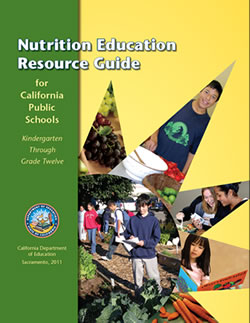 Resources
Resources
Nutrition Education Resource Guide
The CDE recently finalized the 2010 Nutrition Competencies and published them in the Nutrition Education Resource Guide. The Nutrition Competencies present a comprehensive and grade-specific structure for providing nutrition education in California classrooms. They define, from kindergarten through grade 12, the nutrition knowledge and skills students need to make healthy food choices for well being and success in school and throughout their lives.
The NSD is providing copies of the final edition of the Nutrition Education Resource Guide for participants in the upcoming SHAPE 2011–12 workshop series, “Nutrition Education That Works!,” as well as for schools in projects with a nutrition education component, such as the 2010 Team Nutrition Grant and the HUSSC. For more information, please contact Heather Reed, Nutrition Education Consultant, by e-mail at hreed@cde.ca.gov.
Check Out the New Healthy and Active Preschoolers Web site: A Nutrition Learning Center for Child Care Centers
The CDE is pleased to announce the new Healthy and Active Preschoolers Web site for child care and development programs. This Web site is a collaborative effort with Fresno City College, Cal-Pro-NET Center and provides current and reliable nutrition and physical activity information to the child care community. The site offers many features including a Learning Center, Activity and Resource sections, and a Calendar of Events which lists meetings and conferences of interest to child care professionals as well as special food-related days and festivals.
Visit Healthy and Active Preschoolers (Outside Source).
The California Healthy Kids Resource Center
By Jacquelyn Russum, MPH, RD, Health Program Manager, California Healthy Kids and After School Resource Centers
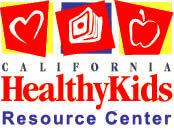 The CHKRC maintains a comprehensive collection of reviewed health education materials for use by teachers, administrators, university faculty, Local Education Authority staff, and other professionals who work with preschool through 12th grade students in school settings and after-school programs. These materials are available for loan from the CHKRC library with free delivery in California.
The CHKRC maintains a comprehensive collection of reviewed health education materials for use by teachers, administrators, university faculty, Local Education Authority staff, and other professionals who work with preschool through 12th grade students in school settings and after-school programs. These materials are available for loan from the CHKRC library with free delivery in California.The CHKRC is funded by the CDE through their After School Programs Office, NSD, and Coordinated School Health and Safety Program, and the California Department of Public Health (CDPH) through the Network for a Healthy California. In addition, the Center provides free 24/7 online trainings, online research and resources, annotated school health laws, and technical assistance to support effective nutrition and health education.
Visit California Healthy Kids Resource Center (Outside Source) for more information.
What’s New at the California Healthy Kids Resource Center?
The CHKRC now offers free 30-minute online trainings on nutrition, physical activity, and health and safety. Log-in 24/7, listen to trainings about cooking with kids and engaging youths in community change, and pass the quiz to receive a certificate.
Looking for resources about new nutrition topics or to improve school food service programs? Try the following topics available for loan at the CHKRC:
- Buzz in a Bottle: The Dangers of Caffeine-Spiked Energy Drinks DVD available at the CHKRC Health Education Library(Outside Source)
- Linking Science and Nutrition Activity Set available at the CHKRC Health Education Library (Outside Source)
- ServSafe – Steps to Food Safety DVD Series available at the CHKRC Health Education Library] (Outside Source)
You can order these resources online at the CHKRC] (Outside Source) or call toll free at 1-888-318-8188.
Stay up to date on new resources by subscribing to CHKRC E-Updates at CHKRC E-Updates Registration (Outside Source).
California Project LEAN Supports Healthy Schools
By Deidre Kleske, Health Educator, California Project LEAN
California Project LEAN (Leaders Encouraging Activity and Nutrition) (CPL) is a joint program of the CDPH and the Public Health Institute. The CPL works to advance nutrition and physical activity policy in schools and communities in order to prevent obesity and its associated chronic diseases. Efforts center on youth and parent empowerment approaches, policy and environmental change strategies, and community-based solutions that improve nutrition and physical activity environments.
CPL worked with Earlimart School District (ESD) to improve the nutrition and physical activity environment at this 2,000 student, pre-kindergarten through eighth grade district in the Central Valley's Tulare County.
With support from a grant from The California Endowment and a cooperative agreement from the Centers for Disease Control and Prevention, CPL, and Tulare County’s Central California Regional Obesity Prevention Program, ESD Food Service Director Clint Lara, and members of the district wellness council recently revised their district’s Wellness Policy. On June 7, 2011, the School Board of ESD approved a revised local school wellness policy that provides staff, students, and parents with clear guidelines on how to create a healthier environment to promote academic success.
The policy covers issues such as water access, beverage standards, and farm to school. It details when and where nutrition education will take place and sets a goal to purchase at least five percent of produce from local growers. It sets standards for beverages provided and sold on campus and eliminates flavored milk (e.g., chocolate) and electrolyte replacement beverages (sports drinks) in middle schools.It also specifies nutrition standards for school fundraising and promotes more physical activity during and after school.
To view ESD’s Wellness Policy, please visit the ESD Food Service Department (Outside Source).
The partnership between the district wellness committee and CPL serves as an example of how positive, sustainable changes in the nutrition and physical activity environment can be made in a school district. For more information, please visitCalifornia Project Lean (Outside Source).
For the latest news and information on CPL's program activities, sign up for e-mail updates at the CPL ENews] (Outside Source) Web page.
Research
Being Well, Learning Well
By Bina Lefkovitz, Consultant, Capitol Impact
New research from the Healthy Students Research Project, conducted by WestEd and the University of California, San Francisco, and supported by The California Endowment, The James Irvine Foundation, and The William and Flora Hewlett Foundation, shows strong linkage between student health and well-being and academic achievement. “Education reform initiatives have focused intently on increasing academic rigor and relevance. While this focus remains essential to student achievement, new research tells us that improvement in academic performance and graduation rates also requires increased support for student health,” according to the summary paper produced by the Healthy Students Research Project advisory committee, entitled Student Health is Vital to Academic Results.
On May 18, 2011, the research papers and policy report were presented at a joint California Assembly Education and Health Committee hearing, chaired by Assembly Member Julia Brownley and Assembly Member Bill Monning, respectively. This hearing provided legislators with critical information on research findings and policy recommendations. Various local school board members, students, and community health agencies spoke about the importance of supporting students by ensuring access to physical activity and healthy foods, better coordinating academic support and health services and making them accessible to students at schools, improving school climate, and better coordinating and leveraging resources, data, and policies at the state level.
The hearing presentation, research briefs, and many more supporting documents are available at Being Well, Learning Well] (Outside Source).
For additional information please contact Bina Lefkovitz, Consultant, Capitol Impact, by e-mail at jbina@sbcglobal.net.
The Institute of Medicine’s Early Childhood Obesity Prevention Policies
The Food and Nutrition Board of the Institute of Medicine (IOM) released a consensus report on June 23, 2011, addressing the issue of overweight and obesity in early childhood (infancy to age five). Early obesity can carry over into adulthood, thus it is crucial to take action and teach kids healthy habits from the start. The IOM proposes actions for implementation and policy recommendations for health care professionals, caregivers, and policy makers for prevention of early childhood obesity. The report focuses on making changes in growth monitoring, physical activity, healthy eating, marketing and screen time, and sleep.
Read more about the goals, recommendations, and potential actions from the report at IOM Early Childhood Obesity Prevention Policies Report] (Outside Source).
F as in Fat 2011
“For the first time, the [F as in Fat] report tracks adult obesity rates in each state over the last two decades. Twenty years ago, no state had a rate above 15 percent. Today, more than two out of three states, 38 total, have obesity rates over 25 percent, and just one has a rate lower than 20 percent,” according to the F as in Fat: How Obesity Threatens America's Future 2011 report released on July 7, 2011.
“This is the eighth annual edition of the F as in Fat report, which tracks trends in obesity rates and policies aimed at addressing the epidemic. The policies reviewed in the report are important inroads in the fight to prevent and reduce obesity, but a greater and sustained national investment is required to reverse the epidemic. The report also features commentaries from top experts who offer their perspectives on key strategies for addressing obesity. The report also features commentaries from top experts who offer their perspectives on key strategies for addressing obesity.”5
You can read the full report of F as in Fat (PDF; Outside Source) at the Trust for America's Health Web site.
Policy Updates
Local School Wellness Policy Update
The Child Nutrition and Women, Infants, and Children (WIC) Reauthorization Act of 2004 (Public Law 108-265, Section 204) included a provision requiring all school districts participating in any federal child nutrition program to establish and adopt a local school wellness policy.
In 2010, Section 204 of the Healthy, Hunger-Free Kids Act of 2010 added section 9A, Local School Wellness Policy Implementation. The new provisions strengthened requirements for ongoing implementation, assessment, and public reporting of wellness policies and also expanded the team of collaborators participating in the policy development. In addition, goals for nutrition promotion are now required.
The federal law requires that, at a minimum, the local school wellness policy:
- Involves parents, students, representatives of school food service, the school board, school administrators, physical education teachers, and the community in the development and implementation of the school wellness policy, with periodic review and updates
- Establishes goals for nutrition education, nutrition promotion, physical activity, and other school-based activities designed to promote student wellness
- Sets nutrition guidelines for all food available on each school campus during the school day
- Provides assurance that guidelines for reimbursable meals will not be less restrictive than federal regulations and guidance issued by the USDA
- Updates and informs the public about the content and implementation of the local wellness policies, including compliance, comparison to model policies, and progress in attaining the goals
For more information, please visit the USDA FNS Local School Wellness Policy (Outside Source) Web page.
SHAPE school districts are leaders in changing school environments to be healthier. As a strategy to create healthier school environments, the NSD encourages you to revise your Local School Wellness Policy to fit the new reauthorization guidelines. We are here to assist you in the process. If you have any questions regarding this subject, please contact Heather Reed, Nutrition Education Consultant, by e-mail at hreed@cde.ca.gov.
Philadelphia's Approach to a Comprehensive School Nutrition Policy Initiative: A Model for Your School’s “Wellness Policy” Success
“In 2003, The Food Trust developed a Comprehensive School Nutrition Policy for the School District of Philadelphia to help youth attain their full educational potential and good health by providing them with the skills, social support, and environmental reinforcement needed to adopt long-term healthy eating habits. The policy is based upon guidelines from the USDA and the Centers for Disease Control.
The Comprehensive School Nutrition Policy Initiative was evaluated by Dr. Gary Foster of Temple University. The initiative was found to reduce the incidence of childhood overweight by 50 percent after two years of implementation. The results were published in the journal Pediatrics.
The multi-disciplinary policy includes these components:
- Nutrition Education in Schools: Students participate in interactive, relevant nutrition education that is integrated into regular subjects in the curriculum.
- Food Services: All food(s) sold at school meet the healthy food requirements and (are) linked to classroom nutrition education.
- Staff Training: Teachers and other staff are equipped to incorporate nutrition education in their curriculum.
- Family and Community Involvement: Families and local community groups participate in nutrition education activities.
- Program Evaluation: The program is evaluated on an ongoing basis and adapted as necessary to improve its effectiveness.”6
For more information and to view the full Comprehensive School Nutrition Policy for the School District of Philadelphia and the results in Pediatrics, visit the Food Trust Comprehensive School Nutrition Policy Initiative (Outside Source) Web page.
The SHAPE E-Newsletter is funded by the California Department of Education.
Works Cited
1 Let’s Move!, 2010. Learn the Facts. Let's Move! Learn the Facts (Outside Source; accessed July 20, 2011).
2 Let’s Move!, 2010. 5 Simple Steps to Success for Chefs. Let's Move! Chefs (Outside Source; accessed July 20, 2011).
3 Karnowski, Steve, “USDA Seeks Ways to Boost Farm-to-School Programs.” ABC News. (July 13, 2011) ABC News (Outside Source; accessed July 20, 2011).
4 National Farm to School Month, 2011. National Farm to School Month] (Outside Source; accessed August 31, 2011).
5 Trust for America’s Health, 2011. F as in Fat: How Obesity Threatens America's Future, 2011 (Outside Source; accessed August 26, 2011).
6 The Food Trust, 2004. Comprehensive School Nutrition Policy Initiative. The Food Trust: Comprehensive School Nutrition Policy Initiative (Outside Source; accessed August 23, 2011).
Questions: Nutrition Services Division | 800-952-5609
